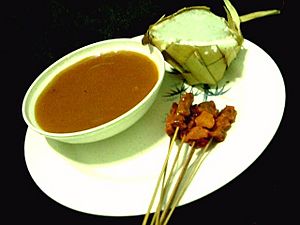Pusô facts for kids
Pusô, also called tamu or "hanging rice," is a special Filipino rice cake. It's made by cooking rice inside a pouch woven from young palm leaves. These pouches come in many cool shapes, like diamonds, rectangles, or even more fancy designs. People all over the Philippines have different names for it, and there are many kinds! It's especially popular as a street food in the Visayan and Moro regions.
Pusô isn't just one recipe; it's a way of cooking and serving rice in a woven leaf pouch. The rice can be plain, savory, or even sweet. What makes pusô unique is the way the leaves are intricately woven into a pouch, unlike other leaf-wrapped Filipino foods where the leaves are simply folded or tied.
Traditionally, pusô was a handy way to pack rice for trips. People would eat it by holding it in their hands, often with grilled meat or seafood on skewers. You can still find it sold this way by street food vendors. If you're sitting down to eat, pusô is usually cut into pieces and served on a plate, just like regular rice.
Long ago, before the Spanish arrived, pusô was important in Filipino culture. It was used as an offering to spirits called diwata. Weaving these pouches was a basic skill for women. Because it was served at religious events, especially the more complex designs, pusô became linked to celebrations. Even today, it's still used in some rituals in the Philippines, though many of these rituals now include Christian traditions. For Muslim Filipinos, pusô is a special food for the Hari Raya feast, which marks the end of Ramadan.
Pusô is similar to dishes found in other rice-growing cultures in Southeast Asia. The most famous one is the Indonesian ketupat, which is usually diamond-shaped and woven a bit differently. A very similar eight-sided version called atupat was also found in Guam long ago, before corn replaced rice farming there.
 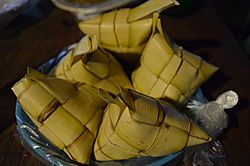
|
|
| Alternative names | hanging rice, poso, pusó, langbay, lambay, linambay, bugnóy, patupat, katumpat, piyoso, pyiusopusu, sinambong, ta’mu, temu, tamu, tam-o |
|---|---|
| Course | Main course |
| Place of origin | Philippines |
| Serving temperature | Hot or room temperature |
| Main ingredients | Rice cooked inside of pouch made from woven young palm leaves |
Contents
What's in a Name?
The word Pusô (also spelled puso, poso, or pusó) means "heart" in the Cebuano language. This is because the most common shape looks like a heart, with two loose ends of the coconut leaf sticking out like blood vessels. Another common name, patupat, means "four-cornered" or "rectangle."
Pusô has many other names depending on where you are in the Philippines:
- Piyusopusó in Mindoro
- Piyoso in Maranao, Iranun, and Maguindanaon
- Langbay, lambay, or linambay in Waray
- Bugnóy in Hiligaynon
- Tam-o in Aklanon
- Tamu, ta’mu, or temu in Tausug and Yakan
- Sinambong, patupat, or pusú in Kapampangan, Pangasinan, and Ilocano
- Katumpat in Sama-Bajau
How Pusô is Made
Pusô is not a specific recipe, but a special way of packaging and serving rice. You can make it with plain white rice or sticky glutinous rice. The rice is poured into a pre-woven leaf container, then boiled. As the rice cooks, the pouch keeps it from spreading, making it into a compact, cake-like shape.
Sometimes, pusô is cooked with meat or flavored with coconut milk and spices like salt or ginger. Other types can be sweet, cooked with brown sugar.
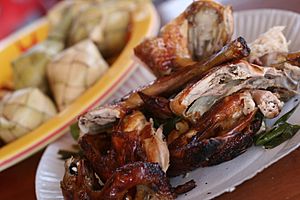
Pusô is different from other Filipino dishes wrapped in leaves, like suman or binalot. Those dishes use leaves that are simply wrapped around the food and tied. Pusô, however, uses leaves that are carefully woven into complex patterns.
Weaving leaves is an ancient art in the Philippines. People use it to make many traditional crafts like baskets, hats, mats, and even toys. Wrapping food in woven leaves, especially banana or coconut leaves, makes it look nice, easy to eat, and gives the food a lovely aroma from the leaves.
Pusô pouches are almost always woven from young coconut leaves, which are pale yellow to light green and very flexible. These young leaves have different names in various regions, like lukay in Visayan areas or palaspas in Southern Luzon. There are many different weaving techniques, leading to many kinds of pusô.
People who weave pusô are traditionally called mamumuso or manlalah in Cebuano.
Cultural Importance
Pusô started as a way to cook and pack rice for travel. It was also very important in the religious rituals of early Filipinos. Smaller or more detailed pusô were often offered to spirits called diwata. Over time, as Filipinos became Christian or Muslim, these traditions changed, but pusô still plays a role.
In some Christianized rituals today, pusô is still used, for example, in prayers for the dead. It's also a regular part of offerings, though now it's usually offered at a Catholic altar or to loved ones who have passed away, rather than to diwata spirits.
For Muslim Filipinos, pusô is a festive food, very popular during Islamic holidays. It's especially linked to the Hari Raya celebrations, which mark the end of Ramadan.
Different Kinds of Pusô
Pusô can be made in many different shapes using various weaving techniques. Some groups have many traditional types, while others stick to one or two. Many techniques are shared across different groups, showing how cultures exchanged ideas long ago.
Here are a few examples of the many pusô variations:
- Binaki – This means "frog-like." It's a common version that looks like a sitting frog with five pointy parts. It's also called kongkang in Palawan, which also means frog.
- Binosa – The smallest type of pusô. It's shaped like a wineglass and is almost always used as an offering to spirits.
- Kinasing – This means "heart-like." It's shaped like a long, eight-sided figure. This is the most common type found in Cebuano-speaking areas like Cebu and Northern Mindanao.
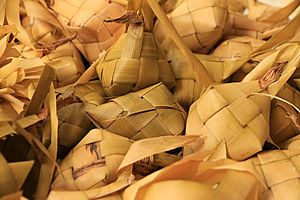
- Minanok – This means "chicken-like." It's a version from Cebu that is shaped like a chicken and used as a ritual offering.
- Patupat – This type, from Northern Luzon, is shaped like a flat rectangle. It's unique because it's always cooked as a dessert, never plain. It's boiled in coconut milk and brown sugar.
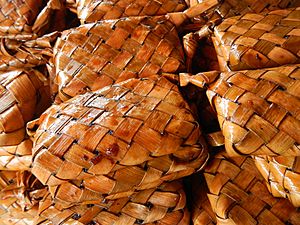
- Pinawikan – This means "sea turtle-like." It's a large version found in Cebu and Negros Oriental.
- Tamu Pinad – This is the most common type used by Tausug people for Hari Raya celebrations. It means "diamond-shaped tamu" and looks like a flattened diamond. It's very similar to the Indonesian ketupat.
A Look Back in History
Leaf-wrapped dishes were some of the first native Filipino foods that the Spanish explorers wrote about when they arrived in the Philippines. The first mention of rice cooked in leaves was in 1525 by Antonio Pigafetta, who described a meal of rice and millet wrapped in leaves, served with roasted fish.
Spanish priests who wrote dictionaries of local languages in the 1600s often described many different types of pusô. They mentioned various shapes and weaving patterns, from simple geometric forms to complex shapes that looked like animals or objects. These writings show how skilled Filipinos were at weaving pusô long ago, even though some of these forms are now lost.
One priest, Fray Mateo Sánchez, described pusô by name in his dictionary from 1615-1617. He noted that women made it and listed fourteen different types, including flat rectangles, brick shapes, and even shapes like a clenched fist or a monkey's head.
Another priest, Juan Jose Delgado, wrote in 1751 about taking pusô with him on trips to the forest. He liked how it kept the rice fresh for longer. He also mentioned that pusô could be cooked with meat inside large pots. He was amazed by the weaving skills, even among children, comparing their creations to complex knots.
Similar Dishes Around the World
Pusô is related to similar dishes in other rice-farming cultures, especially in Southeast Asia. The Indonesian ketupat is a well-known example, though it usually refers to diamond or triangular shapes. Ketupat are also woven differently, and their leaf ends don't come out at the same point like most Filipino pusô. They are also popular during Eid al-Fitr, similar to how tamu is celebrated by Muslim Filipinos.
In Bali, Indonesia, a similar diamond-shaped version called ketipat or tipat is used as an offering to the rice goddess Dewi Sri.
An eight-sided version called atupat was also found in Guam before the Spanish introduced corn, which replaced much of the island's ancient rice farming.
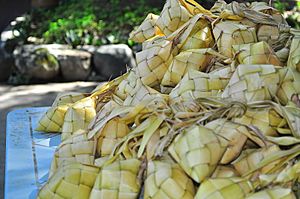
Images for kids
-
Binaki-style pusô with inihaw (Filipino barbecue)


